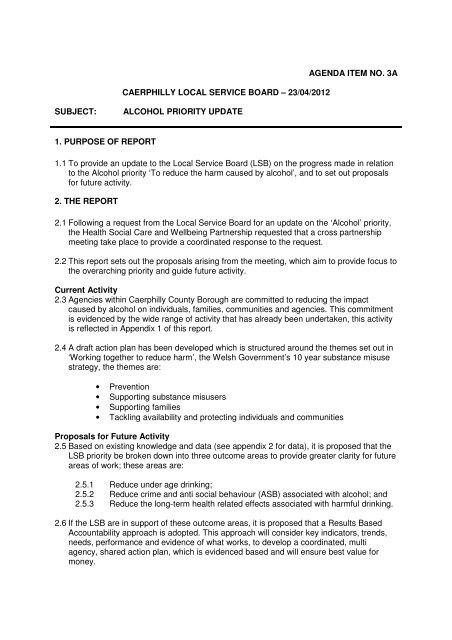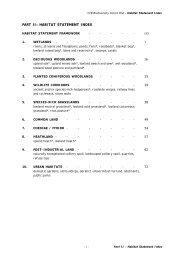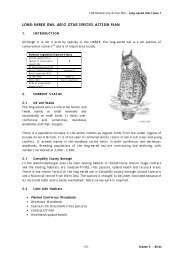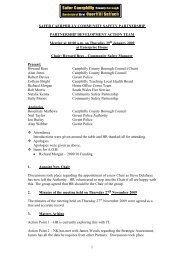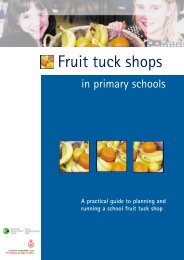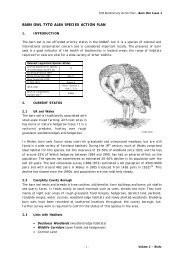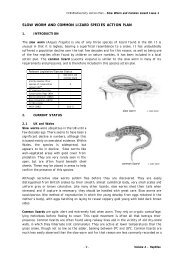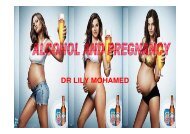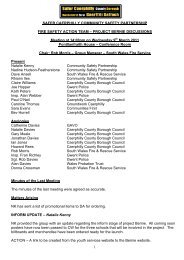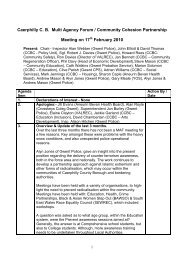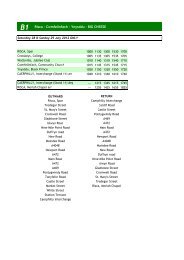ALCOHOL PRIORITY UPDATE 1. PURPOSE OF REPORT 1.1 To p
ALCOHOL PRIORITY UPDATE 1. PURPOSE OF REPORT 1.1 To p
ALCOHOL PRIORITY UPDATE 1. PURPOSE OF REPORT 1.1 To p
Create successful ePaper yourself
Turn your PDF publications into a flip-book with our unique Google optimized e-Paper software.
CAERPHILLY LOCAL SERVICE BOARD – 23/04/2012<br />
AGENDA ITEM NO. 3A<br />
SUBJECT:<br />
<strong>ALCOHOL</strong> <strong>PRIORITY</strong> <strong>UPDATE</strong><br />
<strong>1.</strong> <strong>PURPOSE</strong> <strong>OF</strong> <strong>REPORT</strong><br />
<strong>1.</strong>1 <strong>To</strong> provide an update to the Local Service Board (LSB) on the progress made in relation<br />
to the Alcohol priority ‘<strong>To</strong> reduce the harm caused by alcohol’, and to set out proposals<br />
for future activity.<br />
2. THE <strong>REPORT</strong><br />
2.1 Following a request from the Local Service Board for an update on the ‘Alcohol’ priority,<br />
the Health Social Care and Wellbeing Partnership requested that a cross partnership<br />
meeting take place to provide a coordinated response to the request.<br />
2.2 This report sets out the proposals arising from the meeting, which aim to provide focus to<br />
the overarching priority and guide future activity.<br />
Current Activity<br />
2.3 Agencies within Caerphilly County Borough are committed to reducing the impact<br />
caused by alcohol on individuals, families, communities and agencies. This commitment<br />
is evidenced by the wide range of activity that has already been undertaken, this activity<br />
is reflected in Appendix 1 of this report.<br />
2.4 A draft action plan has been developed which is structured around the themes set out in<br />
‘Working together to reduce harm’, the Welsh Government’s 10 year substance misuse<br />
strategy, the themes are:<br />
• Prevention<br />
• Supporting substance misusers<br />
• Supporting families<br />
• Tackling availability and protecting individuals and communities<br />
Proposals for Future Activity<br />
2.5 Based on existing knowledge and data (see appendix 2 for data), it is proposed that the<br />
LSB priority be broken down into three outcome areas to provide greater clarity for future<br />
areas of work; these areas are:<br />
2.5.1 Reduce under age drinking;<br />
2.5.2 Reduce crime and anti social behaviour (ASB) associated with alcohol; and<br />
2.5.3 Reduce the long-term health related effects associated with harmful drinking.<br />
2.6 If the LSB are in support of these outcome areas, it is proposed that a Results Based<br />
Accountability approach is adopted. This approach will consider key indicators, trends,<br />
needs, performance and evidence of what works, to develop a coordinated, multi<br />
agency, shared action plan, which is evidenced based and will ensure best value for<br />
money.
2.7 It should also be noted that through the needs analysis, which will form the basis for the<br />
LSB Single Plan, additional data will be identified to help further quantify the impact<br />
alcohol is having on our communities. This will in turn help identify meaningful outcome<br />
measures and assist in future planning.<br />
2.8 It is recommended that any future work around alcohol misuse is guided by regional or<br />
national approaches and in particular to the Gwent Area Planning Board’s (APB)<br />
substance misuse strategy and commissioning plan, which is currently in development.<br />
2.9 Alcohol harm reduction is currently a priority for the Health Social Care and Well-being<br />
Partnership and the Community Safety Partnership. More specifically, Alcohol Harm<br />
reduction is in the terms of reference of the Community Safety Partnership’s Prevention,<br />
Education and Training Group. Alcohol is also a priority of the Health Social Care and<br />
Well Being Partnership’s Well Being Network. There is a link between these groups to<br />
avoid duplication of effort. It is proposed that representatives from these 2 groups take<br />
forward the Action Planning process.<br />
2.10 Caerphilly County Borough Council has accepted an invitation to fulfil a Leadership<br />
role in relation to alcohol across the Gwent area which means that not only will<br />
Caerphilly be guided by the APB, but that Caerphilly will also guide the APB in terms of<br />
alcohol misuse priorities. As a result of this leadership role, Caerphilly will host a<br />
regional alcohol conference, organised by Public Health Wales colleagues alongside<br />
Area Planning Board partners, in the Autumn of this year.<br />
3. CONSULTATIONS<br />
3.1 The views of those consulted are included in the report.<br />
4. RECOMMENDATIONS<br />
4.1 The Caerphilly Local Service Board is recommended to:<br />
4.<strong>1.</strong>1 Endorse the outcomes areas suggested in 2.5 above.<br />
4.<strong>1.</strong>2 Endorse the development of a shared evidenced based action plan for all<br />
agencies with a view to collective action and partnership working to reduce<br />
the harm caused by alcohol<br />
4.<strong>1.</strong>3 Endorse that the proposed approach is delivered through the Health, Social<br />
Care and Well-being Partnership and Community Safety Partnership.<br />
Authors:<br />
Consultees:<br />
Tiffany Thackwray, Social Care and Well-being Coordinator and Kath<br />
Peters, Community Safety Manager<br />
Rob Hartshorn, Head of Public Protection, Caerphilly County Borough<br />
Council<br />
Chris Edmonds, Planning Manager, Aneurin Bevan Health Board<br />
Howard Rees, Partnership Development & Collaborative Improvement –<br />
Programme Manager<br />
Sandra Aspinall, Corporate Director: Education, Lifeling Learning and<br />
Leisure, Caerphilly County Borough Council
Albert Heaney: Corporate Director: Social Services, Caerphilly County<br />
Borough Council<br />
Sian Martin. Locality Director: Health Social Care and Well-being<br />
Partnership<br />
Jackie Williams, Senior Health Promotion Practitioner, Health Promotion<br />
Wales
Appendix 1: See Attached<br />
Appendix 2: Alcohol related data<br />
Underage data<br />
The graph below show the results of test purchases undertaken by under 18 year olds in on<br />
and off licensed premises.<br />
% Alcohol sales from test purchases<br />
%<br />
50<br />
40<br />
30<br />
20<br />
10<br />
0<br />
2008/09 2009/10 2010/11 2011/12<br />
Year<br />
Off licence<br />
On licence<br />
In 2005/2006 amongst 11-year olds in Wales 7% of boys and 4% of girls said that they drink<br />
alcohol at least once a week. For 13-yearolds, this percentage rises to 23% of boys and 20%<br />
of girls (Health Behaviour of School Age Children 2005/06)<br />
Crime data<br />
The table below shows the reduction in the number of crimes committed where people were<br />
under the influence of alcohol, between 201/11 and 2011/12.<br />
All crime in Caerphilly LPU with<br />
under the influence of alcohol tag<br />
Violent crime in Caerphilly LPU<br />
with under the influence of alcohol<br />
tag<br />
Number of Crimes (April<br />
– February)<br />
2010/11 2011/12 Diff % Diff n<br />
1110 941 -15.2% -169<br />
853 698 -18.3% -156<br />
Health data<br />
The table below shows data relating to key health indicators associated with alcohol.<br />
Wales Caerphilly<br />
Adults who reported drinking above guidelines 44 % 46 %<br />
Adults who reported binge drinking 27 % 29 %<br />
Hospital admission rate due to alcohol (males) 1940 2095*<br />
Hospital admission rate due to alcohol (females) 1073 1160*<br />
Death rate from alcohol (males) 43 42<br />
Death rate from alcohol (females) 17 17<br />
*Statistically significantly worse compared to Wales<br />
Source: Welsh Health Survey 2010 and Public Health Wales 2010


